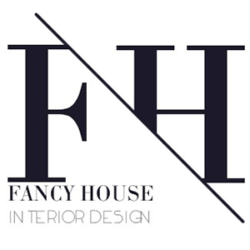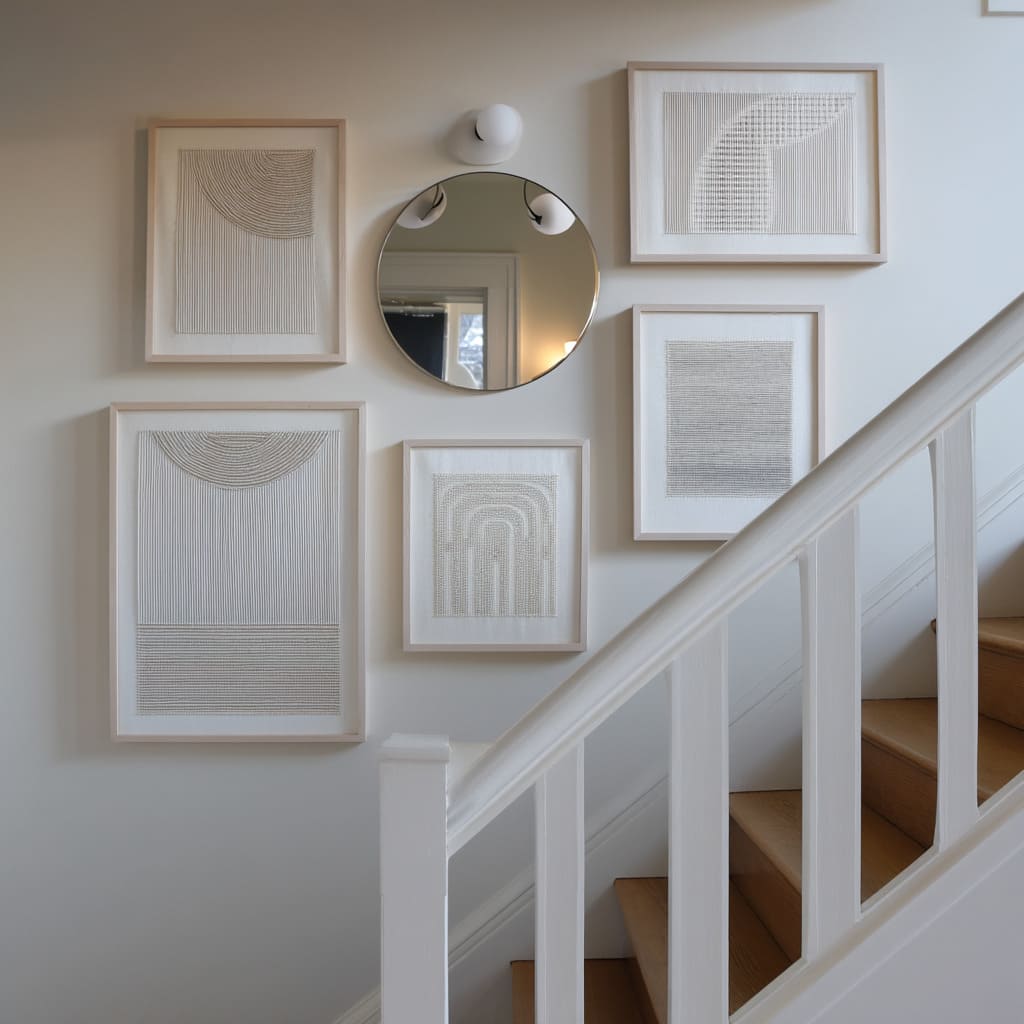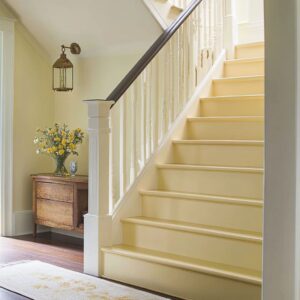A stairwell gallery wall has the potential to do much more than fill a vertical gap. In many homes, this space becomes a frame within the architecture—one that speaks through light, repetition, and material connection.
While most stairwells are transitional by nature, the best examples use this vertical volume as an active part of the interior, not just something to pass through.
What stands out isn’t only the artwork, but how it’s placed—how frames line up with stair angles or resist them, how textures pull forward in soft daylight, and how mirrors, sconces, or ledges shift the mood of the wall without drawing attention to themselves. These details work together with the movement of the stair, shaping how space feels as it unfolds from one level to the next.
This article looks closely at the choices behind these walls. From subtle material echoes to controlled asymmetry, and from tonal rhythms to framing depth, each section breaks down the building blocks that make a stairwell gallery speak fluently with its surroundings.
Material Echo & Spatial Continuity
In many refined examples of a gallery wall in a stairwell, one of the strongest organizing threads is how materials used for the stairs quietly reappear within the wall arrangement. This kind of material reflection isn’t loud—it’s built into the details.
Light oak stair treads are frequently paired with frames in similar pale wood tones. The match may not be exact, but the visual dialogue between floor and frame keeps the installation grounded.
Grain patterns in the wood often line up subtly, drawing the eye upward with a sense of quiet structure.
Metal elements also play a role. Warm-toned brass sconces or brushed steel lights show up again in frame corners, mounting hardware, or even the edges of mirrors.
These choices build connections across space without relying on repetition. A stair rail finished in bronze may find its echo in a narrow frame or pendant light, making the whole section of the house feel continuous.
Some stairwells go further by tying in color values across surface and art. A terracotta-toned abstract piece might hang just above red oak treads, creating a visual chain between underfoot texture and wall composition.
This loop—floor to wall to artwork—acts like a soft outline for the space, holding each piece inside the overall flow of the stair.
Rather than treating frames as simple containers for pictures, this kind of decorating uses them as parts of the architecture. The frame is no longer background—it participates in the stair’s form, subtly extending the materials already in motion.
Deliberate Disruption for Visual Anchoring
Not all gallery wall layouts aim for evenness. Some of the most visually engaging ideas rely on carefully placed interruptions that shift the rhythm of the composition.
These breaks give the viewer something to pause on—something that stands apart from the flow without breaking it entirely. Mirrors often take on this role.
Used vertically, they behave like structural supports within the layout, not just for reflection but for balance. Whether tall and narrow or wide and vintage, a mirror can pull the viewer’s eye upward or center the entire wall, cutting through a grid of artwork and forming a calm axis.
It quietly organizes without drawing too much attention.
There are layouts that intentionally ignore symmetry. A circular artwork in a sea of rectangles or a mirror placed slightly off from center can reframe the whole wall’s movement.
These small irregularities don’t feel like mistakes; they highlight everything else around them. A viewer might first notice the break, but the deeper effect comes from how it resets the eye’s path across the wall.
One of the more unexpected disruptions comes from lighting. A chandelier with sculptural weight—perhaps layered wires or a floating orb—can interrupt the flatness of a wall filled with frames.
In one layout, the soft drama of the chandelier gives tension to a gallery of strict black-and-white photographs, breaking their straight-line discipline without clashing. These interruptions become most effective in stairwells where vertical space is compressed and visual flow can become predictable.
The key to hanging pictures on a stairwell wall with impact isn’t filling every inch—it’s knowing where to stop the rhythm and let something unexpected hold the weight.
Depth Management Through Framing Type & Wall Light Interaction
Some stairwell gallery walls are more than visual compositions—they shift depending on the hour, the weather, or the light source nearby. That movement comes not from the artwork itself, but from how the wall is built to interact with depth and light.
It’s a quiet but impactful technique, shaping the surface with dimensional framing and the choreography of shadow.
Shadowbox frames are a frequent choice in these layouts, used for their ability to lift the artwork forward slightly. The space between the art and the frame glass becomes a shallow chamber where shadows can form.
These soft layers of depth play especially well in stairwells that catch angled sunlight or where ceiling lighting drops from above. The artwork starts to carry sculptural qualities—even the flat pieces seem to have form and edge.
Some layouts take it further with acrylic sandwich frames. These mount the artwork between transparent layers, with the piece floating slightly away from the wall.
The effect is light and minimal, but it creates a shifting halo as natural light passes behind the art. These mounts don’t just hold the image—they project it outward, suspending it like an object instead of treating it as flat decor.
Then there’s the role of light itself. In many cases, the lighting is not aimed directly at the artwork.
It’s placed to the side, or angled downward, so that the light grazes the surface of the wall, pulling forward the texture of paper grain, paint layers, or fabric. Even when the artwork stays the same, the stairwell changes its feel over time.
The artwork becomes something temporary, flickering between stillness and movement.
This kind of visual shift is especially effective when hanging pictures in a stairwell, where vertical space can feel static. With careful light and thoughtful framing, the wall becomes less of a backdrop and more of an active, shifting presence in the room.
Softening Geometry with Organic Subject Matter
Many stairwells follow a structure shaped by lines—vertical railings, angled treads, right-angled wall planes. Within that strict framework, some of the most balanced gallery walls manage to ease the geometry without erasing it.
The method isn’t to fight the angles but to introduce visual counterpoints—subjects that carry texture, fluidity, or natural rhythm. Botanical pieces are one of the most commonly used tools for this purpose.
Whether it’s a pressed specimen, a palm sketch in ink, or a watercolor rendering of a plant form, these images bring in curvature and asymmetry. Their stems bend where stair spindles stay straight.
Their edges blur softly where stair corners remain hard. The plant imagery holds its ground while diffusing the grid around it.
Fiber-based artwork adds another layer of quiet contrast. Unlike traditional prints, these pieces rise off the wall in small ripples, folds, or woven panels.
Their value lies less in color and more in touch—visually touchable, even if never physically reached. Hanging such textile forms next to precise lines gives the wall a sense of breath and pace, softening the severity of a stairwell filled with hard-edged detail.
Coastal themes, too, find their way into these walls—not through clichés, but through abstracted photos of coral structures or wide-water views in pale tone. Their slow movement and spacious composition feel at ease with the stillness of a staircase.
Especially in stairwells that catch sunlight, these images take on a floating quality that resists the tension of rigid layouts. When hanging photos in stairwell zones where geometry dominates, these organic elements give quiet relief.
They don’t erase the architecture—they help it relax, guiding the eye through without force, offering form without strict repetition.
Spatial Interaction Between Wall and Staircase Volume
A stairwell isn’t just a tall hallway—it’s a shifting set of surfaces, levels, and angles. The most carefully considered gallery walls in these areas don’t simply occupy a space on the wall.
They respond to it. The arrangement of pictures in a stairwell often bends with the architecture, giving the impression that the artwork is part of the stair’s structure, not added after.
Some layouts stretch across corner walls, especially in tight turns or split-level landings. Instead of keeping artwork on one plane, the frames wrap around the corner, forming a visual envelope that holds the viewer from multiple angles.
This kind of setup works with the natural turn of the body as people move through the stair—what’s visible from below is different than from above, and the gallery responds to both. In contrast, there are compositions that hold steady lines in spite of the incline.
Frames are kept horizontally level even as the stair rises beside them. This resistance to the pitch gives a sense of calm—like a pause in motion—breaking the constant upward slant with a flat visual breath.
Then there are the staggered layouts that gently mimic the angle of ascent. These don’t follow the stair exactly but echo its rhythm.
A frame might be placed a step above the last, with enough spacing to breathe, creating a loose diagonal that respects the flow of movement without copying it rigidly. Each of these methods treats the wall not as a blank background but as a physical partner in the composition.
The stairs rise, bend, and shift—and the artwork bends with them. The result is a layered spatial interaction, where pictures don’t sit on a wall but move with the space they inhabit.
Compositional Rhythm Through Repetition and Variation
Gallery walls in stairwells often rely on more than shape and color—they work through timing. The arrangement of frames across a vertical space can feel like a sequence, where consistency builds the base and small breaks guide attention.
In many of the best examples, the rhythm isn’t a byproduct—it’s the structure itself. One of the clearest methods for setting pace is repetition.
Narrow sketch studies, identically matted and evenly spaced, create a quiet tempo. In stairwells that are tall or narrow, this type of rhythm is especially effective—it stretches the visual field without overstimulation.
Even when the artwork differs slightly, the matching format keeps everything moving in time.
But too much repetition can flatten a composition. That’s where slight disruptions make the difference.
A single black frame in a sea of pale wood. One vertical piece set among horizontals.
These shifts act like commas in a sentence or rests in a musical phrase—pauses that recalibrate the viewer’s attention and give shape to the progression.
There’s also a subtle connection to the architecture beneath. Stair treads create their own rhythm—step after step, evenly spaced.
When frame groupings echo this with similar intervals or slight upward shifts, the gallery starts to feel like it belongs to the structure. It isn’t floating separately; it’s part of how the stair moves.
Think of it this way: arranging frames across a stairwell isn’t a math problem to solve. It’s a composition with repetition, variance, and tone.
The wall carries its own pulse, and the best gallery layouts don’t just fill space—they keep pace with it.
Final Observations
What makes stairwell gallery walls stand out in the most thoughtfully planned homes isn’t just the artwork—it’s how they’re built into the shape and rhythm of the space itself. These are not surface decorations.
They operate like part of the architecture, giving structure to what would otherwise be blank transitional zones. They define height, redirect visual weight, and bring cohesion to spaces where layout, light, and material often shift abruptly.
The type of artwork chosen—be it ink sketches, soft fiber compositions, or pared-back linework—does more than fill a frame. It either softens the vertical pull of the stair or adds a counterpoint to strong lines already in place.
Every piece plays a role in balancing motion and stillness, density and pause.
What might seem secondary—mirrors, shelf edges, curved wall sections, or the direction of a sconce—turns out to carry just as much weight in the final effect. These details aren’t background support.
They’re treated as equal parts of the composition, shaping how the entire wall works as a spatial layer. Reflections bend the perspective.
Ledges add visual rest. Light falls not only to illuminate but to sculpt.
In the best examples, these gallery walls are doing something quiet but essential. They anchor vertical space, draw together fragmented materials, and give rhythm to the way one moves through a home.
And all of it happens between steps.


























